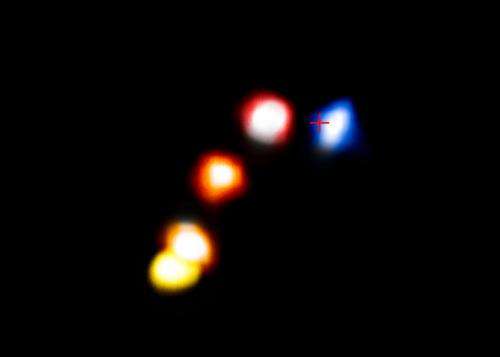Best view yet of dusty cloud passing galactic center black hole

The best observations so far of the dusty gas cloud G2 confirm that it made its closest approach to the supermassive black hole at the centre of the Milky Way in May 2014 and has survived the experience. The new result from ESO's Very Large Telescope shows that the object appears not to have been significantly stretched. It is most likely to be a young star with a massive core that is still accreting material.
A supermassive black hole with a mass four million times that of the Sun lies at the heart of the Milky Way galaxy. It is orbited by a small group of bright stars and, in addition, an enigmatic dusty cloud, known as G2, has been tracked on its fall towards the black hole over the last few years. Closest approach, known as peribothron, was predicted to be in May 2014.
The great tidal forces in this region of very strong gravity were expected to tear the cloud apart and disperse it along its orbit. Some of this material would feed the black hole and lead to sudden flaring and other evidence of the monster enjoying a rare meal. To study these unique events, the region at the galactic centre has been very carefully observed over the last few years by many teams using large telescopes around the world.
A team led by Andreas Eckart (University of Cologne, Germany) has observed the region using ESO's Very Large Telescope (VLT) over many years, including new observations during the critical period from February to September 2014, just before and after the peribothron event in May 2014. These new observations are consistent with earlier ones made using the Keck Telescope on Hawaii .
The images of infrared light coming from glowing hydrogen show that the cloud was compact both before and after its closest approach, as it swung around the black hole.
As well as providing very sharp images, the SINFONI instrument on the VLT also splits the light into its component infrared colours and hence allows the velocity of the cloud to be estimated. Before closest approach, the cloud was found to be travelling away from the Earth at about ten million kilometres/hour and, after swinging around the black hole, it was measured to be approaching the Earth at about twelve million kilometres/hour.
Florian Peissker, a PhD student at the University of Cologne in Germany, who did much of the observing, says: "Being at the telescope and seeing the data arriving in real time was a fascinating experience," and Monica Valencia-S., a post-doctoral researcher also at the University of Cologne, who then worked on the challenging data processing adds: "It was amazing to see that the glow from the dusty cloud stayed compact before and after the close approach to the black hole."
Although earlier observations had suggested that the G2 object was being stretched, the new observations did not show evidence that the cloud had become significantly smeared out, either by becoming visibly extended, or by showing a larger spread of velocities.
In addition to the observations with the SINFONI instrument the team has also made a long series of measurements of the polarisation of the light coming from the supermassive black hole region using the NACO instrument on the VLT. These, the best such observations so far, reveal that the behaviour of the material being accreted onto the black hole is very stable, and—so far—has not been disrupted by the arrival of material from the G2cloud.
The resilience of the dusty cloud to the extreme gravitational tidal effects so close to the black hole strongly suggest that it surrounds a dense object with a massive core, rather than being a free-floating cloud. This is also supported by the lack, so far, of evidence that the central monster is being fed with material, which would lead to flaring and increased activity.
Andreas Eckart sums up the new results: "We looked at all the recent data and in particular the period in 2014 when the closest approach to the black hole took place. We cannot confirm any significant stretching of the source. It certainly does not behave like a coreless dust cloud. We think it must be a dust-shrouded young star."
More information: This research was presented in a paper "Monitoring the Dusty S-Cluster Object (DSO/G2) on its Orbit towards the Galactic Center Black Hole" by M. Valencia-S. et al. in the journal Astrophysical Journal Letters. www.eso.org/public/archives/re … eso1512/eso1512a.pdf
Journal information: Astrophysical Journal Letters
Provided by ESO





















